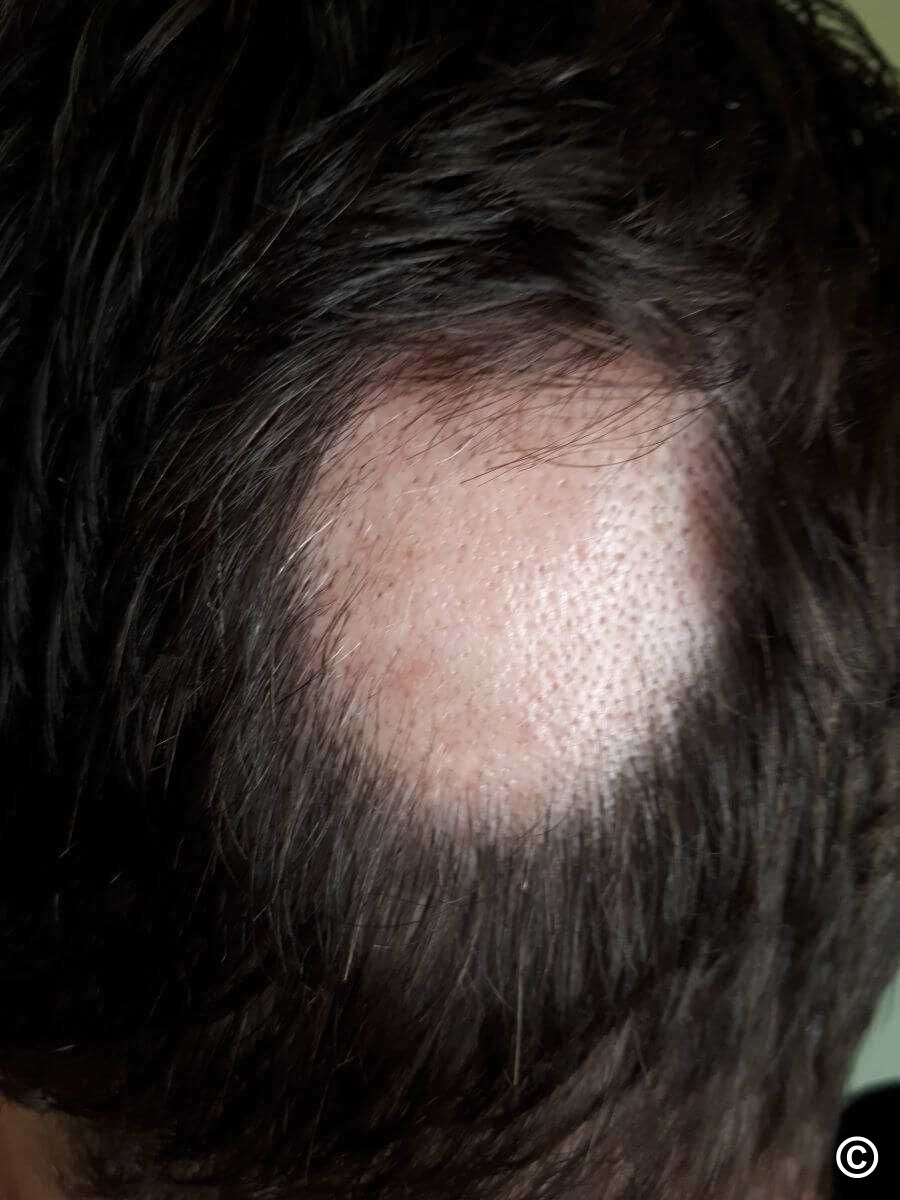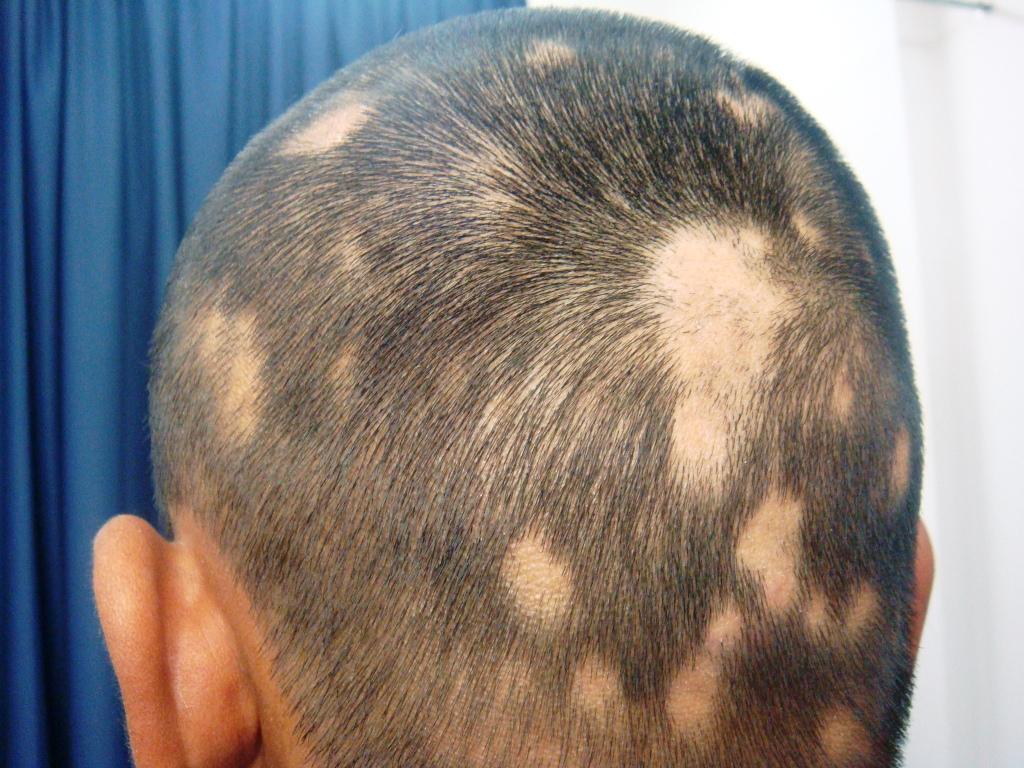ALOPECIA AREATA belongs to the non-scarring type of disease and is an autoimmune condition with possible hereditary factors. Clinically, it is characterized by the appearance of clearly defined patches of round or oval-shaped hair loss on the scalp. It is most commonly observed in young women and men.
Hair loss can persist for a long period, or it can occur almost instantaneously. The patches affected by alopecia areata can persist for many years. This condition is considered autoimmune, where the body’s reaction to antigens is abnormal.
Millions of people suffer from a condition where hair falls out in round patches. This condition is called alopecia areata.
Usually, the disease appears suddenly—one day everything is normal, and then almost overnight, hair falls out, leaving round, small bald patches on the scalp.
Alopecia areata is an autoimmune disease, meaning the body’s immune system mistakenly identifies a part of the body as a foreign threat, like a virus. It is one of the most common types of hair loss, surpassing only genetic hair loss in frequency.
The most characteristic symptom of alopecia is round bald patches, as the immune system attacks the hair follicles in this area, leading to hair loss.
The factors causing alopecia development are still not precisely identified by doctors. In fact, to this day, this disease remains a significant mystery for medical professionals.
The fact remains that this is an autoimmune disease and the second most common cause of hair loss—after genetic hair loss, known as androgenetic alopecia.
Many people find hair loss to be a traumatic or shocking event since it happens suddenly. Because the hair falls out in very distinct circles, hair loss can be very noticeable.
Alopecia Areata Causes and Symptoms
Alopecia areata (or spot baldness) is an autoimmune disease. Suddenly and without any apparent reason, the body identifies hair follicles, where hair roots form, as foreign bodies and starts attacking them accordingly.
This leads to an inflammatory reaction in the affected area, causing hair to fall out very rapidly. Round or oval hairless patches, distinctive to this condition, remain, often with broken hairs along their edges.
In some cases, mainly pigmented hairs fall out, while gray hairs remain. If a person has many gray hairs, only they remain, creating the impression of premature graying.

To this day, it is not entirely clear what causes alopecia areata. Similar to genetic hair loss (genetic predisposition), it is assumed that some people are more predisposed to it than others. There is often a family history of the disease, occurring in approximately 25% of cases in a family member or close relative.
Furthermore, people with Down syndrome or vitiligo often suffer from focal hair loss. Symptoms can also arise in connection with thyroid diseases such as Graves’ disease or Hashimoto’s. Persistent stress is also sometimes thought to trigger the development of alopecia areata.
Localized hair loss can occur on the scalp as well as the entire body.
SYMPTOMS
Alopecia areata is characterized by a sudden onset and the appearance of round or oval areas with well-defined borders that become completely bald, having a smooth surface. These patches can appear not only on the scalp but also on other parts of the body. In some cases of this condition, redness and slight itching can be observed on the hairless areas. Nail plate involvement is also common, with small indentations resembling sandpaper.
Usually, alopecia areata appears as an independent condition, but sometimes it is accompanied by other pathologies such as vitiligo, dermatitis, Hashimoto’s thyroiditis, and others. The course of this type of alopecia is unpredictable. It disappears in almost half of the patients within a year even without any treatment, while on the other hand, about 85% of patients experience multiple episodes.
Types and Symptoms of Alopecia Areata
There are five different types of alopecia areata:
- Multilobular Alopecia: Bald patches appear in several places on the head.
- Unilocular Alopecia: Hair falls out only in one spot on the head.
- Total Alopecia: All hair on the head falls out.
- Universal Alopecia: Instead of isolated patches of hair loss, all body hair falls out.
- Ophiasis Alopecia: Hair falls out in a crown-like pattern on the neck and ears (this is a distinctive and unusual form of the disease).
The good news is that with all forms of alopecia areata, after the episode ends, patients are able to regrow their hair.
However, the complexity of alopecia lies in the fact that the disease usually occurs in episodes. This means, for example, that patchy hair loss can reappear as soon as the hair starts to grow back. Quite often, as a side symptom, spotted or ridged nails appear.
 In men, circular hair loss can also occur in the beard area (alopecia areata of the beard). The disease can also affect eyebrows and (very rarely) body hair.
In men, circular hair loss can also occur in the beard area (alopecia areata of the beard). The disease can also affect eyebrows and (very rarely) body hair.
If the beard is affected, it can be shaved during an alopecia areata episode. Since the area around the affected spot is also free of hair, this makes it almost unnoticeable.
Especially in the case of Multilobular Alopecia Areata and Unilocular Alopecia Areata, wearing headgear is recommended, at least as a temporary solution. If a person’s hair does not grow back properly after an episode, hair transplantation in Turkey can be a solution to the problem. You can learn more about the service by following the link above.
Diagnosis of Alopecia Areata
To diagnose alopecia areata, the following methods are used:
EXTERNAL EXAMINATION AND SPECIALIST CONSULTATION.
PHOTOTRICHOSCOPY. An indispensable and effective method for diagnosis, it reveals black narrowed points and distally expanded hairs in the shape of an exclamation mark. It is very useful for monitoring ongoing therapy.
DERMATOSCOPY. This is a non-invasive diagnostic method using a special optical device called a dermatoscope. During this process, various formations on the skin with specific symptoms that the doctor can observe visually are identified. At Euroderm clinic, modern equipment FotoFinder medicam 1000 equipped with D-Scope Lens IV lens, which magnifies the examined object 20-140 times, is used. The optical zoom is controlled by a special device on the device’s body and from the program itself. Dermatoscopy is performed:
- For malignant skin tumors.
- For precancerous conditions.
- For any other formations to reduce the risk of mistaken removal.
- For almost all types of hair and skin diseases.
LABORATORY ANALYSES AND STUDIES. In some cases, general and biochemical blood tests, evaluation of hormonal changes, and other studies prescribed by the doctor individually for a specific patient might be necessary.
BIOPSY. A sample is taken from a specific area of the hairy part of the scalp for further histological examination and pathomorphological analysis. This technique allows for an accurate and final diagnosis. Punch biopsy provides a sample consisting of all layers of the skin: epidermis, dermis, and subcutaneous fat layer. Instruments with diameters ranging from 1.5 to 8 millimeters are used for material sampling. One procedure lasts about half an hour with local anesthesia applied. There is no preparatory period required.
Advantages of punch biopsy:
- The procedure is performed without preparation.
- It allows for a quick and highly accurate diagnosis of skin diseases.
- It has minimal contraindications.
- Material sampling is done without traumatizing healthy tissues surrounding the pathology.
Punch biopsy is recommended in the following cases:
- Chronic dermatoses and dermatitis that persist and recur frequently.
- To refine the presumed diagnosis of any skin pathology.
- Benign and oncological neoplasms.
- Systemic collagenoses.
- Bullous pathologies.
- Mycoses (fungal infections).
The procedure is contraindicated in case of poor blood clotting and the patient’s personal intolerance to the medications used during punch biopsy.
 Since the exact cause of the disease is still unknown, there is currently no effective treatment for alopecia that guarantees hair regrowth.
Since the exact cause of the disease is still unknown, there is currently no effective treatment for alopecia that guarantees hair regrowth.
In mild cases of alopecia areata, hair can regrow within three to six months. However, this spontaneous recovery can last for years.
In this case, the doctor, usually a dermatologist, treats only the symptoms of the disease, such as using zinc tablets. Therapy with cortisone and prednisolone can also be effective. However, they are associated with significant side effects since these drugs suppress the immune system. This also makes the patient vulnerable to other diseases and medical conditions.
Meanwhile, significant progress has been made in the treatment of alopecia areata through topical immunotherapy. In this treatment, the scalp is sensitized with special allergens. The resulting reaction should stimulate hair growth.
In some cases, the immune reaction leading to hair loss may be related to prolonged and intense stress. It may happen that if the stress subsides, the immune reaction weakens, and after some time, normal hair growth may resume.
However, the possibility of applying such therapy always depends on the specific case. Moreover, such treatment is carried out only in specialized medical practices or clinics.
In any case, if you are suffering from alopecia areata, it is recommended to consult a doctor.
Treatment
The choice of treatment for alopecia areata is made by a specialist considering the patient’s age category and the severity of the disease.
Corticosteroids (anti-inflammatory drugs) are used for treatment. These can be ointments, creams, lotions, or injection solutions that are injected directly into the affected skin areas or intramuscularly.
Corticosteroid injections are mainly prescribed for adults, repeated every 1-1.5 months, and initial results can be noticeable within 4-8 weeks after the first injection. To reduce the pain from the injection, the future injection site is pre-treated with an ointment or cream with anesthetic effect. Sometimes, topical corticosteroids (sometimes in combination with minoxidil) are also prescribed.
Modern medicine is constantly evolving, researchers discover new diagnostic and treatment methods. For instance, the mechanisms of alopecia areata development have been recently uncovered, allowing new approaches to the treatment of this condition. It has been recently established that gamma-interferon and certain cytokines play an important role in the pathogenesis of autoimmune pathology. This discovery has led to the development of new techniques and medications for effective therapy. In any case, only a professional doctor can develop an optimal treatment plan applicable to a specific condition of a particular patient.
If alopecia areata continues to progress during or after therapy, to improve the appearance, patients are recommended to purchase and wear a wig. Since this condition causes psychological discomfort, emotional support is essential, helping the patient identify positive coping methods. Collaborative efforts between the doctor and the patient are necessary to address this issue.
Hair Transplantation for Alopecia Areata?
In principle, hair transplantation is possible for alopecia areata, especially when hair no longer grows with its previous density and bald patches remain.
However, it is crucial for alopecia areata to be completely cured. Otherwise, there is a risk that the immune system will attack the newly transplanted follicles, causing them to fall out again.
An experienced trichologist will carefully examine the balding area to ensure there is no risk of the immune system attacking the transplanted hair follicles.
A reputable hair transplant clinic will never pressure you into getting a transplant. In cases of alopecia areata, hair transplantation can yield good results but is suitable only under specific circumstances. Under the wrong conditions, it might do more harm than good.